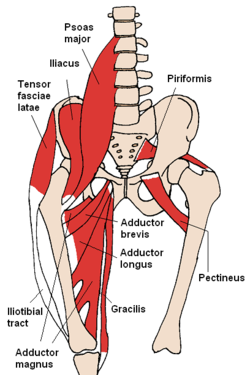Tensor fasciæ latæ
| Tensor fasciae latae | |
|---|---|

The tensor fasciae latae and nearby muscles
|
|

The position of the tensor fasciae latae in the male pelvis
|
|
| Details | |
| Pronunciation | /ˈtɛnsər ˈfæʃi.i ˈleɪti/ |
| Origin | Anterior superior iliac spine |
| Insertion | Iliotibial tract (via greater trochanter) |
| Artery | Primarily lateral circumflex femoral artery, superior gluteal artery |
| Nerve | Superior gluteal nerve (L4, L5, S1) |
| Actions | Hip - flexion, medial rotation, abduction, knee - lateral rotation, Torso - stabilization |
| Identifiers | |
| Latin | Musculus tensor fasciae latae |
| TA | A04.7.02.010 |
| FMA | 22423 |
|
Anatomical terms of muscle
[]
|
|
The tensor fasciae latae (or tensor fasciæ latæ) is a muscle of the thigh. It is related with the gluteus maximus in function and structure and is continuous with the iliotibial tract, which attaches to the tibia. The muscle assists in keeping the balance of the pelvis while standing, walking, or running.
It arises from the anterior part of the outer lip of the iliac crest; from the outer surface of the anterior superior iliac spine, and part of the outer border of the notch below it, between the gluteus medius and sartorius; and from the deep surface of the fascia lata.
It is inserted between the two layers of the iliotibial band of the fascia lata about the junction of the middle and upper thirds of the thigh. The tensor fasciae latae tautens the iliotibial band and braces the knee, especially when the opposite foot is lifted. The terminal insertion point lies on the lateral condyle of the tibia. (contrary to what the picture shows at the right)
Tensor fasciae latae is innervated by the superior gluteal nerve, L5 and S1. At its origins of the anterior rami of L4, L5, and S1 nerves, the superior gluteal nerve exits the pelvis via greater sciatic foramen superior to the piriformis. The nerve also courses between the gluteus medius and minimus. The superior gluteal artery also supplies the tensor fasciae latae. The superior gluteal nerve arises from the sacral plexus and only has muscular innervation associated with it. There is no cutaneous innervation for sensation that stems from the superior gluteal nerve.
The tensor fasciae latae is a tensor of the fascia lata; continuing its action, the oblique direction of its fibers enables it to stabilize the hip in extension (assists gluteus maximus during hip extension). The fascia lata is a fibrous sheath that encircles the thigh like a subcutaneous stocking and tightly binds its muscles. On the lateral surface, it combines with the tendons of the gluteus maximus and tensor fasciae latae to form the iliotibial band, which extends from the iliac crest to the lateral condyle of the tibia.
...
Wikipedia
